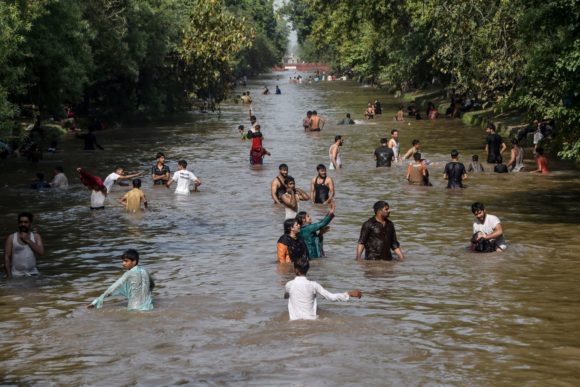A few years ago, several top climate researchers joined forces to launch a data-intensive economics research project that promised the most careful estimates yet of how much damage warming may bring and what it implies for the cost of climate change.
Today, Climate Impact Lab published its first major results, related to how rising incomes can help blunt killer heat in a warming world. The top-line conclusion: Rich nations may have resources available to try and adjust to life under higher temperatures. People in poor, already hot nations are more likely to have to pay with their lives.
The study, a National Bureau of Economic Research working paper, is part of an even longer enterprise.

Typically, when governments search for what’s called the “social cost of carbon,” they estimate an economy-wide, complete number. Over the years, these approaches have been criticized, in part because the damages are overly generalized and not rooted in vast amounts of local and national data aggregated into a global picture.
So Climate Impact Lab has broken that enormous challenge into several incrementally smaller ones. They are going sector by sector across the global economy, determining first how climate change will impact death from heat-related causes, before moving on to energy, agriculture, labor productivity, coastal infrastructure, and manufacturing.
The first problem they encountered was instructive: a lack of data. They couldn’t project heat mortality statistics for almost half the world, because nations don’t or are unable to collect them. They got around that by scientifically establishing a relationship between heat and death for 41 countries representing 55% of the world’s population, and then statistically extrapolating to provide estimates to the rest of humanity. That left them with a worldwide picture of heat mortality.
Such a feat in itself would have been interesting, but it was just the opening salvo in an enterprise several times more massive that concludes with some sobering news. Climate change is going to be an order of magnitude more expensive than the authors previously thought.
Consider this: The all-in cost estimate of a ton of CO₂, using Obama-era calculations, is $50, an approach that has been tested in courts. The new work suggests the price from heat mortality alone — not including hits to agriculture, manufacturing, energy, coasts, and more — reaches almost $38, in a high-emissions future. That means the new all-in cost estimate of a ton of CO₂ may be several times higher than that. It’s not incalculably high. They just haven’t calculated it yet.
How to calculate the social cost of carbon has long provoked debates because of the many difficult choices behind it. Some of the key questions include:
- How much damage will climate change cause? This used to be a coarse assumption. Climate Impact Lab has built its estimates up from basic science and economics to be able to estimate damages (from heat alone, in the new study) with more precision than ever.
- What are future generations worth to us, today, in dollars? The “discount rate” that economists choose can steer the carbon price up or down dramatically. The new paper bases its rates on previous research and on the rates of 10-year Treasury Inflation-Indexed Securities.
- How high will CO₂ climb? The work uses standardized emission projections, one higher than is likely and one lower than is likely. (More nuanced counterparts are on their way.)
In recent years, some economists have asked if a massive exercise that evolved out of the U.S. federal rule-making process is even necessary for global and national climate policy making.
Noah Kaufman, a research scholar at Columbia’s Center on Global Energy Policy, said he thought the way Climate Impact Lab built its global estimates from real-world heat and economic data was impressive. He said that in general social-cost of carbon estimates — “the most difficult question in the world” — requires too many assumptions to extrapolate over a century. Policy officials have, rightly so, he said, spent more time in recent years talking about other things, such as the 1.5°C temperature limit enshrined in the Paris Agreement, or ambitions to zero-out emissions by mid-century.
“This is an issue where policy makers are ahead of economists,” he said.
The Trump administration kept the legal framework requiring the social-cost of carbon, and changed some key assumptions. This led to an economy-wide all-in price of between $1 and $7 a ton. This approach was recently described by the U.S. Government Accountability Office as not taking into account scientists’ recommendations. Resource economists have questioned its key assumptions, too.
The social cost of carbon, despite its wonkiness, is nonetheless a useful anchor for policy makers when considering climate risks as they explore solutions. Without the data and analysis, climate talk is cheap.
“Everybody understands there are damages associated with climate change, and that can be brought up in policy debate,” said Michael Greenstone, a University of Chicago economist and a Climate Impact Lab co-director and co-founder. “But it tends to get run over unless there is some empirical foundation.”
Was this article valuable?
Here are more articles you may enjoy.

 Singer’s Elliott Sued by PE Firm in Escalating Fight Over Money
Singer’s Elliott Sued by PE Firm in Escalating Fight Over Money  Palantir Poaching Suit Called ‘Scare’ Tactic by Ex-Employees
Palantir Poaching Suit Called ‘Scare’ Tactic by Ex-Employees  California Bill Would Require Insurer Claims Handling Plans, And Double Penalties
California Bill Would Require Insurer Claims Handling Plans, And Double Penalties  The Return Period for An LA Wildfire-Scale Event May Be Shorter Than You Think
The Return Period for An LA Wildfire-Scale Event May Be Shorter Than You Think 